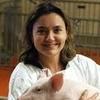Explore all the information on
Swine vaccines
Vaccinations are available for a number of diseases that affect swine. In some cases vaccination constitutes the major part of the control of the disease. In many other cases it is only a small part of the control program. Vaccination programs need to be tailored to each swine operation. Remember that vaccination only raises a pig's level of resistance. If other important management procedures are neglected, even this elevated level of resistance may be inadequate to prevent disease.
Vaccines must be stored and administered according to label directions if they are to be effective. Slaughter withdrawal time must be observed at all times to avoid illegal residues. The most common times for administering many vaccines are before breeding and before farrowing. This protects the sow and passes antibodies to the piglets for their protection.
Introduction There is growing advocacy for antibiotic-free (ABF) livestock production to minimize the emergence of antibiotic-resistant foodborne pathogens and subsequent human exposure to these treatment-refractory organisms [1–4] This trend has been driven by the escalating presence of antibiotic resistance, including multi-drug resistance, among a variety of important bacterial pathogens that infect both animals and humans [5,6]. In food-animal settings, resistant...
Comments : 0
Recommendations: 0
Introduction: There are two registered vaccines available (Clostriporc A, Enteroporc A, IDT Biologika GmbH) to prevent suckling piglet diarrhea caused by Clostridium perfringens type A (CpA). These are based on the α- and β2-toxoids. The goal of this study was to evaluate the development of antibodies against the α- and β2-toxins after recurrent vaccination of gilts with ENTEROPORC A under laboratory conditions. Materials and...
Comments : 0
Recommendations: 0
Introduction: The purpose of this study was to demonstrate the economic benefit and improved yield of groups of gilts vaccinated with SUISENG®, on a farm with a high prevalence of neonatal diarrhoea caused by E.coli/Clostridium . Materials and Methods: 49 clinically healthy, PRRSV-positive and ADV-negative gilts were selected on a farm with 800 sows, and divided into 4 groups, 2 vaccinated (V1 n=13; V2 n=12) and 2 not vaccinated (NV1 n=12;...
Comments : 0
Recommendations: 1
...
Comments : 0
Recommendations: 0
Introduction - vaccines against parasites In modern swine medicine, vaccination against various pathogens is an integral part of the health management. However, currently not a single vaccine against parasites of swine is commercially available. Compared to viral and bacterial pathogens, there is a general scarcity for anti-parasite vaccines; only two anti-nematode vaccines, one antitick-vaccine and a handful of antiprotozoal vaccines are available for domestic animals....
Comments : 1
Recommendations: 0
A presentation prepared for the 24th International Pig Veterinary Society Congress and 8th European Symposium of Porcine Health Management at the Royal Dublin Society (RDS) Dublin, Ireland 8th June 2016. Porcine reproductive and respiratory Syndrome Virus (PRRSV) is the most economically significant infectious disease of swine worldwide. Due to the great impact of PRRS in many key swine producing areas of Asia, Europe and the Americas, the epidemiological situation created by...
Comments : 0
Recommendations: 0
Introduction For economic reasons, the pig industry is marked today by a phenotypic inbreeding for production parameters that might result in a genotypic linkage with an altered (compromised) immune responsiveness. A well-developed immune system and optimal immune responsiveness remain important for the welfare and productivity. Indeed these qualities can only be obtained if the health status of the animal scores high. Therefore a lot of energy and money is invested in...
Comments : 0
Recommendations: 0
The dissemination of ASF and the challenges involved in containing its damage were the topics of discussion during the IPVS’ Panel presented online at the 333 Experience Congress, held on November 19th, which brought together...
Comments : 0
Recommendations: 0


A Vietnamese study showed a lower bioavailability for methionine hydroxy analog calcium salt relative to MetAMINO® in starter pigs
Suggested link
1. Introduction With 1766–1768 nucleotides, porcine circovirus type 2 (PCV2) is the smallest genomic panzootic associated virus among the circular single-stranded DNA (ssDNA) viruses hitherto. These ssDNA viruses are remarkably understudied, and only recently have researchers begun to study these viruses due to the advent of next-generation sequencing in birds, fish, mammals, and even humans [1,2]. The small genome of PCV2 encodes at least nine different transcripts...
Comments : 0
Recommendations: 1
It is now possible to train the first line of defence system of animals. This will not only help to be better protected against diseases, it also creates a stronger and better vaccine response. This immune training can be done with beta-glucans from yeast. What are the benefits for pigs? We are more...
Comments : 1
Recommendations: 2
Introduction The emergence of Porcine reproductive and respiratory syndrome virus in the 1980s and early 1990s was a turning point in the ways in which diseases were dealt with in pig farms. The impact of the disease, its rapid spread worldwide (by 1993 the infection was present in America, Europe and Asia) and the unusual features of the virus made evident that a vaccine was urgently needed to try to control the infection. The first vaccine...
Comments : 0
Recommendations: 0
Introduction Streptococcus suis (S. suis) is a major porcine pathogen responsible for important economic losses to the swine industry. In fact, it is one of the main causes of bacterial death in post-weaned piglets, from 5 to 10 weeks of age. According to the Canadian Swine Health Information Network, S. suis-related diseases are the most common infectious problem reported in Canadian swine farms. In addition, the Monitoring and Analysis Working...
Comments : 2
Recommendations: 0
Introduction The controversy that disease was transmitted by invisible life forms stretches back centuries dating to Aristotle (300BC) who believed that all life originated from soil and Virgil (40BC) who believed that bees came from honey and maggots originated from warm meat. It was Spallanzani who showed that no maggots arose from boiled meat while others showed that simple cotton filters could prevent spontaneous generation of life from warm meat. The...
Comments : 0
Recommendations: 1
The Pasteurellaceae family and its importance in pig production The Pasteurellaceae family is comprised of a group of Gram-negative coccobacilli bacteria that inhabit the respiratory, oral or gastrointestinal tracts of different animal species and can cause a wide range of infectious diseases in animals and humans. The family includes at least three important and well-characterized bacterial genera; namely, Pasteurella ,...
Comments : 0
Recommendations: 0
Dr. Chris Chase (South Dakota University) discussed what to do in a pandemic situation and how to apply this knowledge to pig production, during this Swine It interview with host Márcio Gonçalves....
Comments : 0
Recommendations: 0
Erysipelas is a contagious infectious disease of pigs caused by the bacterium Erisipelothrix rhusiopathiae. The Swine Erysipelas is an actual disease, as reported Schwarts (AASV 2002) with the increase of cases at the University of Iowa, with economic impact in the herd losses may include loss of death (1%) - $ 2.50dls/hembra; treatment cost $ 1/hembra; abortion (4%) - $ 5dls/hembra for a total of $ 10dls/hembra. Also in the growth stage - complete the death loss (3%) - $ 2.50dls; treatment...
Comments : 0
Recommendations: 1
By Jordan Bartel/NC State Veterinary Medicine
We know a lot about antimicrobial resistance, but understand even less.
We know how it moves across farms, between animals, people and borders, and we also know how to track it. We know it doesn’t discriminate, impacting wealthy cities and impoverished nations, and we don’t have a universal approach to stop it. We know how we can eliminate using certain antibiotics that contribute to resistance,...
Comments : 0
Recommendations: 0
1. Updates on BVDV Infection in Swine Bovine viral diarrhea (BVD) is an infection caused by the bovine viral diarrhea virus (BVDV), belonging to the genus Pestivirus, family Flaviviridae, with single-stranded positive polarity RNA [1]. Viruses belonging to the Pestivirus genus infect hosts of several animal species and include viral agents of great impact for animal production [2,3]. The Pestivirus species have been recently named from A to K and, among them, the Pestivirus A...
Comments : 2
Recommendations: 0


A Vietnamese study showed a lower bioavailability for methionine hydroxy analog calcium salt relative to MetAMINO® in starter pigs
Suggested link
Influenza A virus (IAV) is a member of the family Orthomyxoviridae possessing 8 negative sense single-stranded RNA segments and classified in subtypes based on the antigenicity of their surface glycoproteins: 18 subtypes for hemagglutinin (HA) and 11 subtypes for neuraminidase (NA). IAV can infect birds and several mammalian species, including human and swine. Pigs have an important role in the ecology of IAV, since they can become infected with both human and avian strains. Co-infection...
Comments : 0
Recommendations: 0
...
Comments : 0
Recommendations: 0











.jpg&w=3840&q=75)














